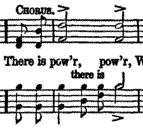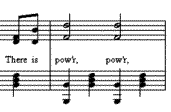The O/C And An Irregular Bass
Some may not feel that this next example is an irregular bass, but I refer to it as such because, first of all, the bass moves but the chord does not, and, secondly, the bass note does not name the chord being played.
 Chorus - Hymnal Version Chorus - O/C Version |
Look at this excerpt taken from the beginning of the Chorus. In particular, we are looking at the portion in which the bass and tenor repeat the words "there is pow'r." As you can see in the illustration, there are two eighth notes on the second beat of this measure (just like in the beginning of the song). What makes this measure different is that the eighth notes are changing in the bass. As such, we will deal with them separately, and then go from there.
Look at the first complete measure shown (not the pickup beat). The first of the pair of eight notes has a D in the bass. Normally, this would indicate a D chord, but the remaining notes, Bb, F, and D (the soprano and alto notes are held over from the first beat), tell us that this is a Bb chord. The second eighth note has an F for the bass. Normally, this would indicate an F chord, but, again, the remaining notes (Bb, F, and D), require that this be a Bb chord as well. Therefore, we know that the second beat of this measure is a common Bb chord.
Upon recognizing that the chord does not actually change despite the variation in the bass, it should be but a simple step to apply the O/C to this musical example. The O/C version is provided below the hymnal version.

